Deck Fighter-bomber F / A-18
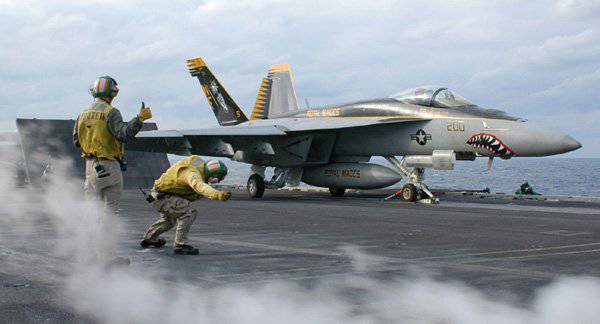
The F / A-18 Hornet carrier-based bomber is today one of the most successful modern combat aircraft and the main combat aircraft. aviation US Navy. History its creation begins in the sixties of the last century, when Northrop designed the P.530 Cobra aircraft. Subsequently, being reworked, he received the designation YF-17 and in 1976 took part in the US Air Force competition to create a light multipurpose fighter. In it, he defeated the project of a similar aircraft of the General Dynamics YF-16. However, Northrop did not have the necessary experience to develop a variant of deck-mounted aircraft. Therefore, further work on the project was carried out in cooperation with the firm McDonnell-Douglas (from 1997, Boeing), who had such experience. McDonnell Douglas took up the development of the F / A-18 carrier-based fighter, while Northrop was developing the ground-based version of the F-18L. The F / A-18 carrier-based fighter was called the Hornet (Hornet).
In the end, the cooperation of the two enterprises turned into a litigation. Northrop accused McDonnell Douglas of illegally using its products. Douglas was able to stop the business, having paid off fifty million dollars. From now on, Hornet has become completely his project. A variant of the F-18L was never launched into mass production.
22 January 1976 announced the launch of the development of two single-seat options, McDonnell-Douglas F-18 and A-18. Later, the aircraft was named Hornet. He was a cantilever mid-plane with folding wings; the tail consists of two carinae, inclined outwardly, and one-piece stabilizers, one on each side of the fuselage, moving together or separately; retractable three-wheeled chassis included a nasal chassis, adapted to start with a catapult; there was a brake hook for landing on an aircraft carrier; The power plant consisted of two General Electric (General Electric) F404-GE-400 turbofan engines with 71 kN thrust.
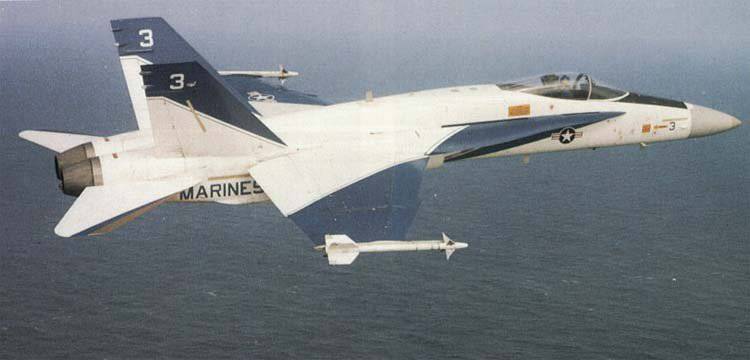
The first of the 11 prototype aircraft took off 18 in November 1978 g. During the 12 months all 11 vehicles plus two two-seat training aircraft TF / A-18A (later renamed F-18B) were tested. The first F / A-18A production aircraft was delivered to the US Navy in May 1980. In the middle of 1980, the aircraft was improved by installing modern electronic and instrumentation equipment and equipping with Maverick AIM-120 and AGM-65F rockets, which were located on nine suspension nodes. The engine was replaced with a more powerful turbofan F404-GE-402. An upgraded aircraft, called F / A-18C, took off on September 3 1986.
When testing the aircraft was not without loss. In 1980, two Hornets were defeated. One failed the engine and there was a fire in the air. The second went into a flat spin and hit the ground. The pilots managed to eject. The latter case was particularly alarmed by experts: does the aircraft have a tendency to stall into a tailspin.
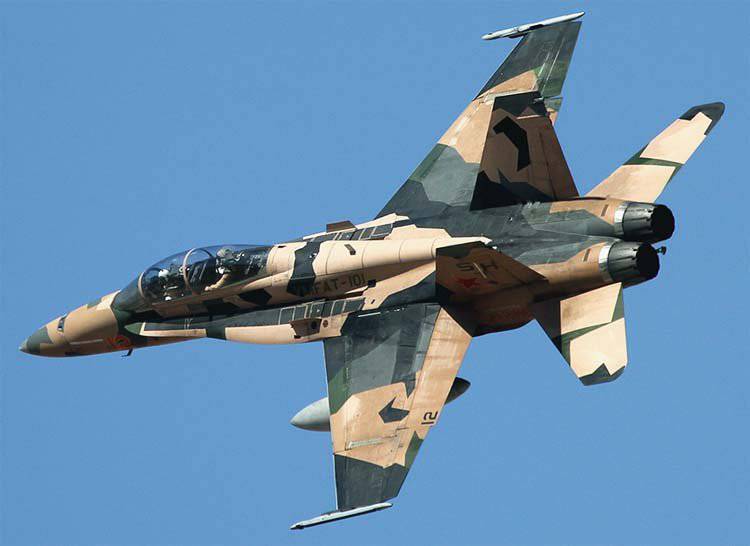
By design, the aircraft F / A-18 - monoplane of a normal circuit with a mid-winged cantilever wing, with two engines in the tail section and two-tail plumage. The fuselage is semi-monocoque design. Above, in the tail section, between the keels, there is an air brake. There, in the tail section, under the fuselage, a brake hook is provided. One of the important features of the "Hornet" are the elongated nodules (nadelki), coming from the front edge of the wing along the fuselage in the direction of air intakes. Large nodules, 5,5 m2, significantly increase the lift force at high angles of attack.
One of the distinctive features of the aircraft is the presence of large areas (5,55 m2) and complex irregular shapes in plan in front of the root parts of the wing. The influxes create a vortex lifting force and ensure the flight of the aircraft at large angles of attack. Between the influxes and the fuselage there is a gap for the removal of the boundary layer of the fuselage from the air intakes. During operation, increased stresses were noted in the rear part of the fuselage and the root part of the keels due to the influence of vortices on them, and since 1988 on F / A-18С fleet In the USA, small vertical ridges are installed on top of the flows, which serve to modify the vortices descending from the flows, with a corresponding reduction in structural fatigue and improved directional control at angles of attack above 45 degrees.
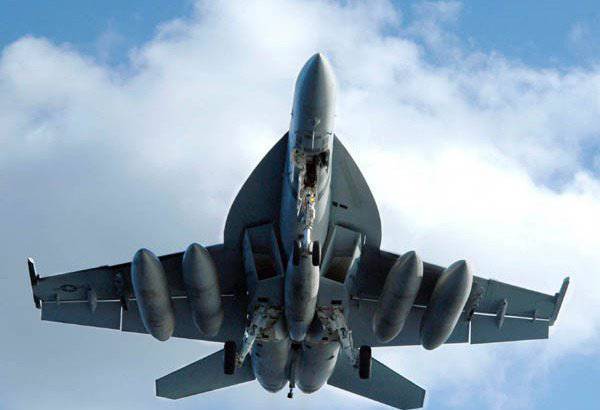
Wing "Hornet" - multi-spar, folding along the hinge joint. The relative thickness of the wing 5%, elongation 3,5. It has a complex system of mechanization: over the whole span - deflected socks, flaps, hanging ailerons with maximum deflection angles 30grad. and 45grad. . It is characteristic that the wing socks and flaps deflect automatically depending on the angle of attack and speed, which significantly increases speed in level flight and maneuverability in combat.
Stabilizer - all-turning, differentially deviating, used for longitudinal, and at supersonic speeds and partially transverse control of the aircraft.
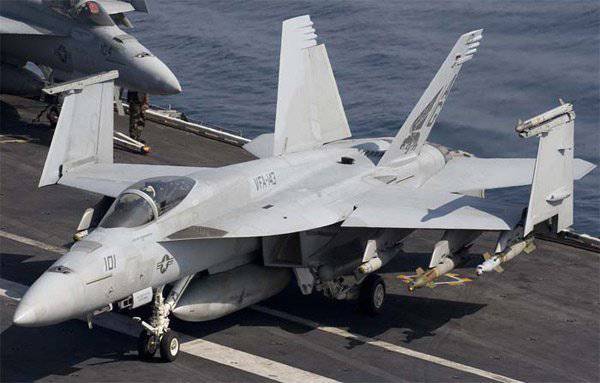
Two arrowed keels have an insignificant angle of external camber and steering rudders of small area. In the upper part of the right keel is the radar radiation warning station antenna. The wing, tail, flaps, ailerons, manhole covers are made using composite materials, the total mass of which is 590 kg.
Chassis "Hornet" - tricycle. The main racks have one wheel each, after turning the wheels on the 90grad. they are retracted into the niches located under the air intakes of the engines. Nasal rack with two wheels retracts forward and has a bracket for attaching to the hook of the catapult. Pneumatics of the main pillars are 25x69 cm and nasal - 20x50, see. It is interesting to note that when operating an aircraft from an aircraft carrier, the pressure in the pneumatics of the racks is 24 kg / cm2, and from a ground runway - only about 12 kg / cm2. The "hydraulics" of the aircraft consists of two independent systems with a working pressure 210 kg / cm2 and is designed to power the actuators of control surfaces, brakes, brake hooks, guns, and other units.
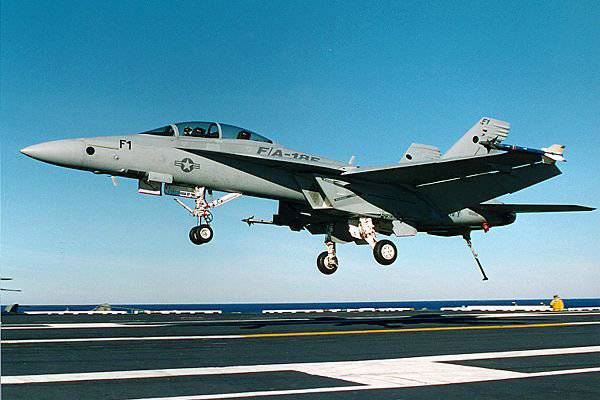
The cockpit - sealed, equipped with air conditioning and oxygen supply. The lamp opens up - back, and the windshield, if necessary, leans up - forward. An ejection Martin-Baker type US10S is installed in the cockpit, providing emergency escape of the aircraft by the crew even in the parking lot. The control system of the aircraft is digital, electrical, with backup electrical wiring to all control surfaces and backup mechanical wiring to control the stabilizer.
Power point. On the YF-17, the YJ101 engines with a forced / unforced 6800 / 4290 kgf engine, with a bypass ratio 0,20 and with a full pressure ratio more than 20, were installed. The development of YJ101 was started by General Electric at 1971 at its own expense. For F / A-18 based on it was created TRNFX F404-GE-400 modular design. This is a two-shaft engine with three- and seven-stage compressors of low and high pressure, respectively, single-stage low and high pressure turbines (with cooled blades) pressure, and annular combustion chamber. Nozzle tapering-expanding adjustable. Electrohydromechanical engine management system. Bypass ratio 0,34, full pressure increase 25, air consumption 64,4 kg / s, engine length 4,03 m, maximum diameter 0,88 m, dry weight 989 kg.
The engines are separated by a titanium fire wall. Side lateral semicircular air intakes are located under the root wings of the wing. The boundary layer cutter juts out in front of each air intake approximately 1 m and removes the boundary layer of the fuselage, directing it up and down from the air intake, directly in front of the air intake, the cutter has perforations through which its own cutter boundary layer is removed. The slam-shut plane makes an angle of 5 degrees, with the direction of undisturbed flow and provides pre-compression of air at supersonic speeds.
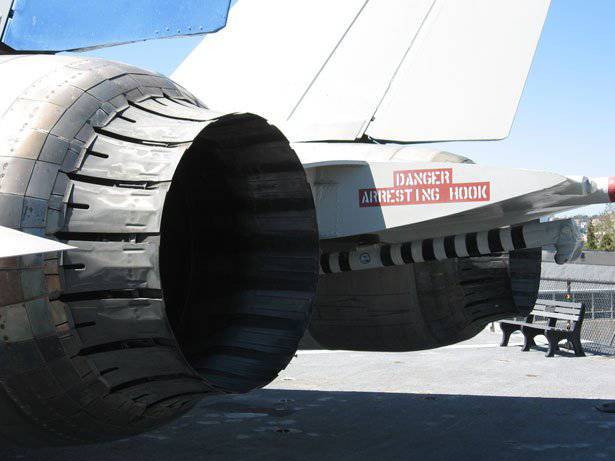
Estimated glider life - 6000 flight hours, or 2000 takeoffs using a catapult and 2000 landings with an air suspension unit.
The internal fuel system tanks are located in the fuselage between the cockpit and the engines, as well as in the center section of the wing. Stock of fuel in them - 5000 kg. Together with the outboard tanks filled, the maximum amount of jet fuel reaches 7990 kg, which makes it possible to reach the maximum distillation range of 3800 km. On the starboard side in the forward part of the fuselage there is a retractable boom for refueling in flight. Tanks and the space around them are filled with flame-retardant foam.
"Hornet" is equipped with first-class electronic equipment that allows you to perform combat missions at night and in adverse weather conditions. It has two 16-bit on-board computer Control of Data AN / AYK-14, Collins inertial navigation system AN / ARN-118 TACAN, instrument landing system, radio compass, friend-to-alien identification system, radio altimeter, two VHF radio, warning system Magnavox AN / ALR-50 radar irradiation, EW system, device for spreading dipole reflectors, IR tracer and radio disturber.
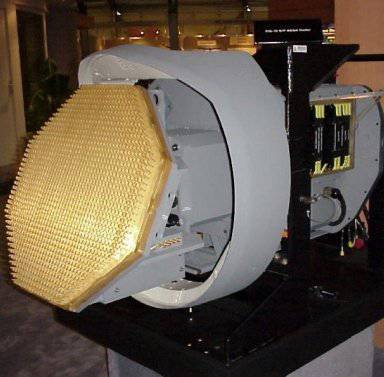
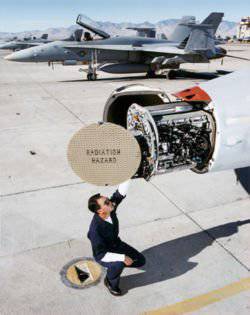
In the cockpit there are three indicators: a multifunctional display, a display of the state of the aircraft’s systems and a situation observation indicator. All displays are interchangeable. In general, the Hornet’s electronic equipment includes a control system weapons, navigation equipment, radio communication and identification equipment, as well as EW facilities. Multi-mode digital pulse-Doppler radar "Hughes" provides tracking at the same time for ten targets and display information on eight of them. This radar operates in air-to-air and air-to-surface modes and provides aiming when firing from a cannon, launching guided missiles (UR) and bombing. At the "Hornet" applied another novelty in the equipment of the radar system. When performing operations on ground targets under containers for air intakes, containers are installed with Ford's IR system and a container with a laser target designation system and a Martin panoramic camera.
The arsenal of weapons F / A-18 is very diverse. Built-in gun M-61-А1 "Volcano" caliber 20 mm. Ammunition - 570 shells, 4000 or 6000 gunfire / min. Rocket-bomb armament is placed on nine external suspension assemblies - one on the wing tips, two under each console and three ventral ones. Maximum load: terminal wing hangers - for 136 kg, outer and inner wing wings - for 1100 kg, under vent - 1090 kg and at the air intake - for 230 kg.
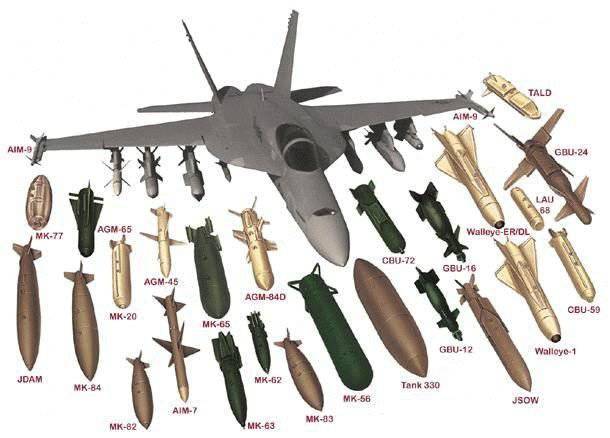
The air-to-air weapons on the Hornet include SE Sidewinder and Sparrow. On the plane, you can simultaneously install 8 such missiles. The air-to-surface class on the F / A-18 can be used by the Mavrick UR, the Harpoon anti-ship UR, the Harm anti-radar, and the Walley guided bombs and the Mk.82, -83 conventional bombs - 84. In addition, the Rokai cluster and nuclear bombs are UAB-2000. All this variety of deadly cargo (with the possible exception of atomic bombs) soon had to be applied in combat conditions.
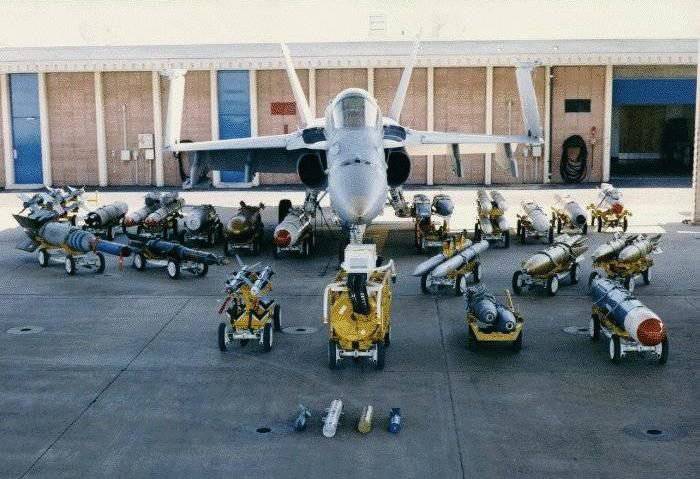
In the middle of the 80-ies there was a difficult political situation in the Mediterranean. A number of Middle Eastern countries were swept by a wave of terrorism. According to US intelligence, the main base of the terrorists were on Libyan territory. At the beginning of 1987, the US 6 fleet, with UN approval, passed through the Strait of Gibraltar and launched a military operation against Libya. Soon it came to skirmishes in the air between the Libyan pilots on the MiGs and the Americans on the F-14 and F / A-18. As the conflict escalated, F / A-18 from aircraft carriers began to be used for assault strikes against missile bases and other military facilities in Libya.
October 15 1986-th aircraft, taking off from aircraft carriers, connected with a group of 18 "Hornets", flown from England. The purpose of the action "Eldorado Canyon" was to work together to strike at a military airfield in Benghazi. The main objective of the "Hornets" was the suppression of Libyan air defense. They were armed with AGM-88 self-guided missiles. When approaching the F / A-18 target, they were hit by C-75 anti-aircraft missiles, but jamming and anti-missile maneuver helped to avoid hits. The combat mission was completed. The military debut of the "Hornets" was successful, and their success was highly appreciated by military experts, once again confirming the opinion of F / A-18 customers that they were not mistaken in their choice.
Modifications:
YF-18A experienced fighter.
F/A-18A single-seat fighter-bomber. 371 aircraft were built for the US Navy and the USMC (1980-1987).
F/A-18B (former designation TF-18A) is a two-seat combat training version of the F/A-18A aircraft. 39 production F/A-18Bs were built for the US Navy and the USMC.
F/A-18C single-seat multirole fighter with improved avionics and armament. First flight - September 3, 1986, deliveries began on September 21, 1987 and ended in 2000. Since the end of 1989, it has been produced in the Night Attack modification with equipment for all-weather night strikes.
F/A-18D two-seat version of the F/A-18C. First flown on May 6, 1988, deliveries began in December 1989 and ended in September 2000. Available with all-weather night strike equipment. The modification for the ILC is made without a command post in the rear cockpit and is designed to perform only combat missions, while the modification for the Navy has dual control and is used only for training tasks.
F/A-18E Super Hornet upgraded version of the aircraft.
F/A-18F Super Hornet two-seat combat training variant.
CF-18A and B single and double versions for the Canadian Air Force. First flight - July 29, 1982, 138 delivered, of which 40 CF-18B - from October 25, 1982 to September 21, 1988.
AF-18A and ATF-18A one- and two-seat variants for the Australian Air Force. 75 aircraft were ordered, including 57 AF-18A and 18 ATF-18A, of which the first two were received from the United States, the rest were assembled or built under license and delivered from May 1985 to May 1990.
EF-18 single (Spanish designation C. 15) and double (SE. 15) variants for the Spanish Air Force. 72 delivered from summer 1986 to June 1990.
F/A-18D(RC) two-seat reconnaissance aircraft with ATARS container system. Flight testing of the F/A-18 with reconnaissance equipment began on August 15, 1984. It was not built in series.
F-18L ground-based variant. Not serially built.
F-18 HARV experimental aircraft for research in 1987-1994. flights at high angles of attack, thrust vector control systems using peripheral rudders and new ways to control the aircraft at high angles of attack (using rotary ridges located in the forward fuselage or a jet blowing system).
Characteristics of the Boeing F / A-18C "Hornet":
Developer Country: USA. Type: tactical fighter-bombarddi ¬ avschik deck and land-based.
Armament: one built-in 20-mm six-barrel gun М61А1 "Volcano"; bomb load up to 7030 kg, which may include air-to-air Class AIR-7M Sparrow, AIM-9 Sidewinder, AIM-120 AMRAAM; Air-to-surface class AGM-65 Mayvrick; anti-radar UR AGM-88 HARM; tactical KP AGM-84ESLAM and AGM-154 JSOW; KAB AGM-62 "Wally", GBU-10, GBU-12 nGBU-16; PCRAEM-84 "Harpoon"; bombs Mk.80; CBU-59 cluster bombs; nuclear bombs B57 or B61.
The number of suspension points - 9.
Engines: two General Electric TRDDFs F404-GE-402 with an afterburner 8035.
LTH:
maximum speed 1915 km / h;
combat radius as an 740 km fighter;
as a strike aircraft - 1065 km.
Ceiling - 15240 m.
Masses:
empty 10810 kg;
maximum takeoff as a fighter 15235 kg;
as a shock - 21890 kg.
Dimensions:
wing span (without SD at the wing ends) 11,43 m;
length 17,07 m;
height 4,66 m;
Wing area 37,16 m.
The result of the first major modernization of the F / A-18C / D Hornet, carried out by McDonnell-Douglas prior to its merging into 1997 with Boeing, was the F / A-18 Super Hornet fighter-bomber. For the first time, the new aircraft took off in November of 1995, and on January 15, 1999 of the VFA-122 squadron received the first production vehicle. "Super Hornet" has a number of differences from its predecessor. In particular, the basis of the improved avionics was a new radar "Raytheon APG-73", which was later installed on the F / A-18C fighter aircraft of later releases.
The built-in REP UES complex consists of three main elements: the ALR-67 (V) 3 radar warning system, the ALQ-214 radio frequency jamming system, and the fake ALE-55 false-target towed by a fiber-optic cable. True, while the last two systems are under development and testing, so now towed false targets ALE-50 are used on aircraft. The new modification has significantly reduced radar visibility from the front and rear hemispheres. The shape of air intakes, which are a strong source of reflection of electromagnetic radiation, has been changed. Air intake channels are curved down and sideways to reflect radiation away from the longitudinal axis of the aircraft. The internal surfaces of the air ducts are made of radio absorbing material. Instead of the grids covering the various suction and output openings on the aircraft, perforated screens were used that were “transparent” for electromagnetic radiation. Considerable attention was paid to fitting a large number of hull panels, and filling cavities between them, which also contributed to reducing the visibility of the aircraft. According to the developers, the Super Hornet aircraft implemented the most ambitious measures to reduce radar visibility among all modern fighters, with the exception of the F-22 and F-35. The F / A-18E fighter's cockpit is similar to the F / A-18C's cockpit, with the exception of one large-size multifunctional flat panel LCD display mounted on the dashboard instead of three cathode displays.
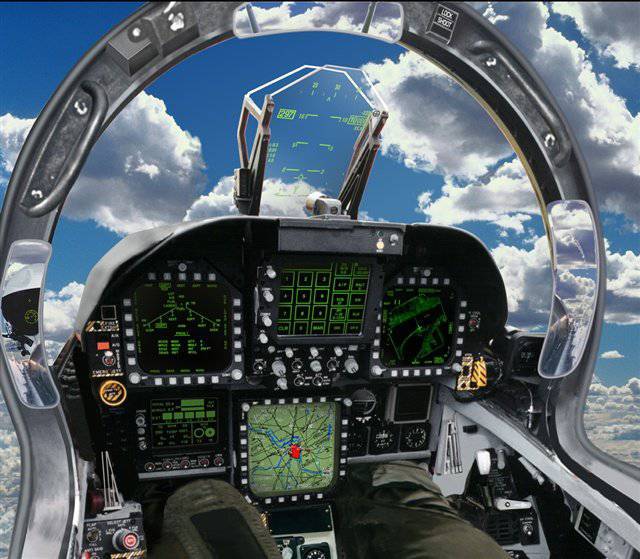
For the construction of "Super Hornets" at the aircraft factory in St. Louis was specially organized by the new assembly line. Rolling out the first experienced F / A-18 took place on September 18 1995, and on November 29 of the same year, he made the first flight. In February, the aircraft was transferred to 1996 at the Naval Aviation Test Center in Patuxen River. The three-year test program was attended by seven vehicles: five single F / A-18E and two double F / A-18F, all of them entered Patuksen-River in 1996, the planes flew ten test pilots: five "branded" and five military.
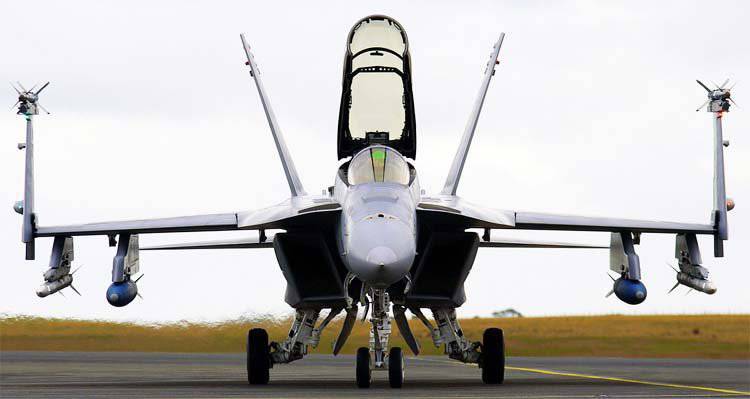
The appearance of the F / A-18E / F will allow the Navy to reduce the heterogeneity of the carrier-based aircraft fleet. It is envisaged that in the first quarter of the 21st century all deck-mounted wings (multipurpose, medium-range attack and long-range attack) lead to a new typical composition: one VF fighter squadron (JSF aircraft), three - VFA fighter-bomber aircraft (F / A-18E / F aircraft) and one support aircraft, as well as DRLO airplanes, 70 aircraft in total, including 38 multi-purpose Super Hornet fighters that will be in service until at least 2020.
The Super Hornet has a slightly increased size, which made it possible to take more effective measures to reduce the radar section. The fuselage is extended by 0,86 m, the oversized wing has a thicker profile and two additional external suspension assemblies. The size of the influx on the toe of the wing in the root part and the area of the horizontal stabilizer and the carinae are increased. The airframe design of the Super Hornet fighter has been improved to reduce weight and reduce the cost of construction without sacrificing strength.
Airplanes are also equipped with advanced digital EDSU, a backup mechanical control system is absent. The F / A-18F Super Hornet is a two-seat version of the F / A-18E fighter. His back cabin has the same equipment on the dashboard as the front one, i.e., it can be used as a place for the operator of weapon systems, as well as for accommodating the trainee student. The US Navy initially intended to purchase 1000 Super Hornet aircraft, but then it was decided to reduce the volume of purchases. Currently produced 432 units of data machines. Currently, these machines remain the backbone of the aviation power of the US Navy, and this situation is unlikely to change in the foreseeable future.
Characteristics of the Boeing F / A-18 Super Hornet:
Developer Country: USA
Type: single-deck tactical fighter-bomber of deck and airfield bases
Armament: one built-in 20-mm six-barrel gun M61А2 "Volcano" with ammunition from 570 shells;
bomb load up to 8050 kg, the composition of weapons is the same as on the F / A-18C fighter.
The number of suspension points - 11.
Engines: two General Electric TRDTFs F414-GE-400 9990 kgf in afterburner mode.
LTH:
maximum speed at high altitude 1915 km / h;
combat radius as an attack aircraft when flying at high altitude with four bombs caliber 454 kg, two SD airborne AIM-9 "Sidewind" class and two dropping PTB - 1095 km,
with 135-minute patrols over the sea with six UR air-to-air and three PTB - 280 km.
Ceiling - 15240 m.
Masses:
empty 13865 kg;
maximum take-off 29940 kg.
Dimensions:
wing span of the 13,62 m (including missiles installed at the wing ends);
length 18,31 m;
height 4,88 m;
Wing area 46,45 m.
Sources:
http://www.liveinternet.ru/community/3629085/tags/fa-18+hornet/
http://www.militaryparitet.com/html/data/ic_news/157/
http://www.warships.ru/usa/Aircraft/Fixed_Wing/F-18_'Hornet'/Hornet.htm
http://www.modernarmy.ru/article/91
http://www.warships.ru/usa/Aircraft/Fixed_Wing/F-18_'Hornet'/Hornet.htm
http://www.airwar.ru/enc/fighter/f18.html
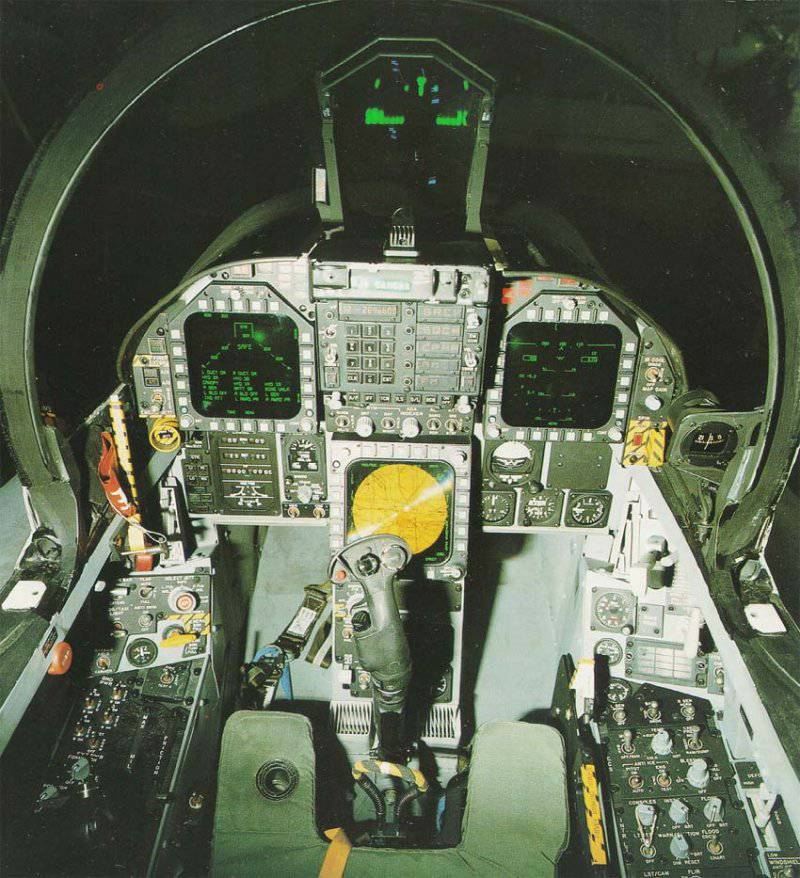
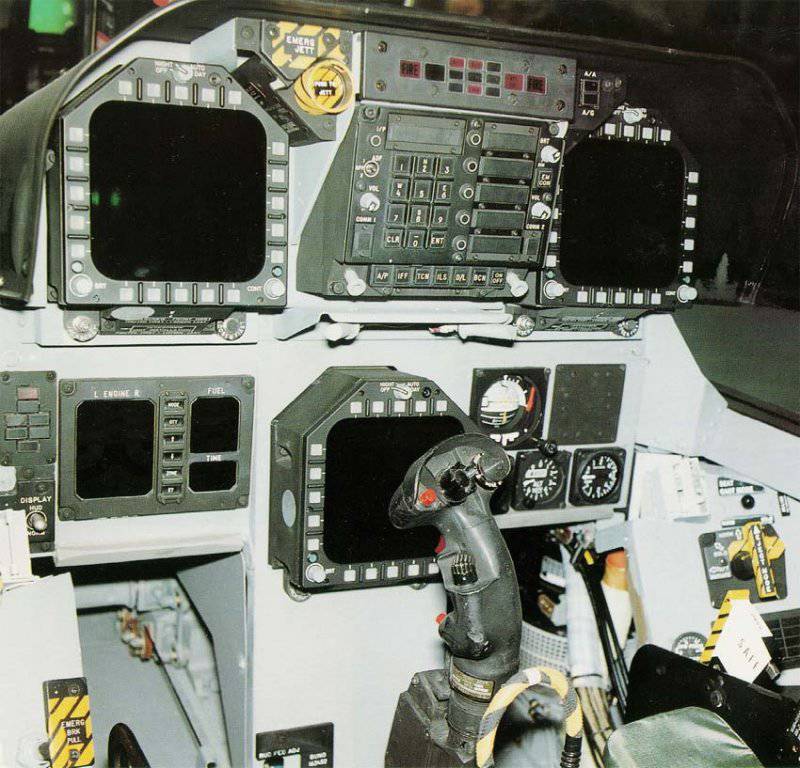
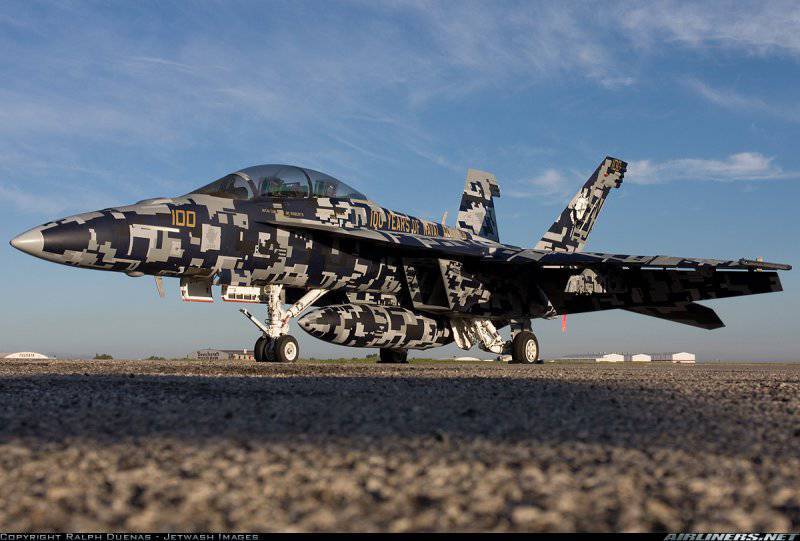
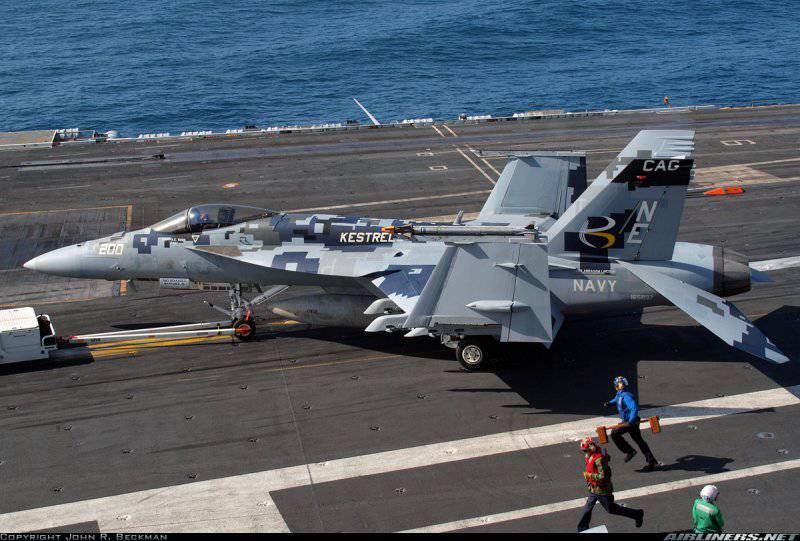
Information